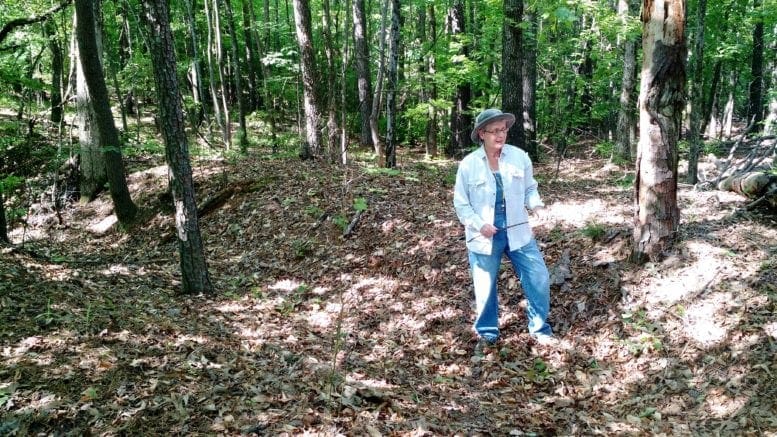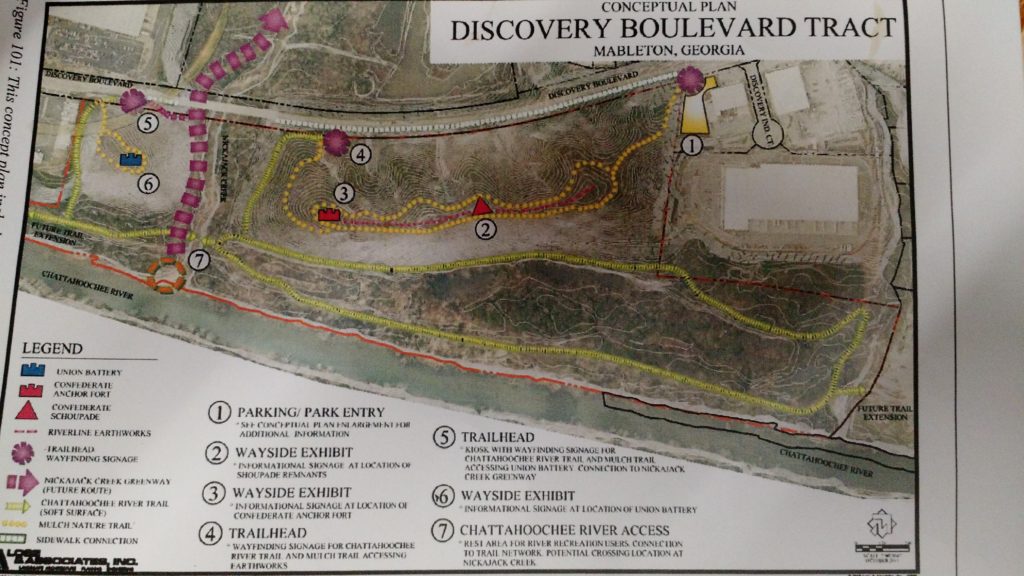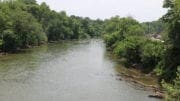It can be hard to believe with so many subdivisions, wide highways, high-rises and now a Major League Baseball stadium operating near the Chattahoochee River, but southeast Cobb County was the scene of some of the Civil War’s most dramatic action over 150 years ago.
More than 100,000 soldiers serving under Confederate General Joe Johnston and Union General William T. Sherman marched through the area and set up massive fortifications during the historic Atlanta campaign, ultimately setting the stage for Sherman’s March to the Sea.
One of the few places where those Civil War trenches remain plainly visible is a 103-acre site near the intersection of Discovery Boulevard and Highway 78 in Mableton. Cobb County has long owned the site and set aside roughly $1 million of special purpose local option sales tax (SPLOST) money to convert it into a passive park.
“The Civil War is a big deal all over the world,” said Roberta Cook, executive director of the River Line Historic Area. “Cobb County’s had this 100 acres along the Chattahoochee for about 30 years now. It has $1 million in SPLOST funding and what I’d like to see is that the park be accessible to the public. But I’d also like to see them feature the historic site in the best possible manner.”
The area includes not only trenches where the Confederates set up shop, but also the remains of Union fortifications built just across Nickajack Creek during the intense days of the war. Cook has proposed naming it “Johnston’s River Line Park,” though no official name has been chosen.
Plans call for trails to be built near a long, deep trench carved out by Confederate soldiers, with signs pointing out the area’s historical significance. Not only is the trench itself preserved, several cannon stations can be clearly seen along with one Shoupade, a unique triangular fortification designed by Confederate Brigadier General Francis Asbury Shoup.
The preserved Shoupade is the southernmost of what originally were 36 such fortifications. Two other Shoupades can be found at Shoupade Park on Oakdale Road, but they’re tightly sandwiched between a subdivision and townhome complex.
Cobb County hopes to hire a design firm later this year and begin construction on the park as early as the fourth quarter of 2018, according to Ed Czyscon, a project manager and landscape architect with The Cobb County Parks, Recreation and Cultural Affairs Department. The plans require extra scrutiny because the park is located within 2,000 feet of the river and creek, lengthening the construction timeline.
“We’ll be trying to limit any kind of footprint of construction on the area,” Czyscon said. “The majority of the elements would be nature trails that would go from a small parking lot to the top of the ridge. It would also be nice to have a nature trail going close to the river.”
But the budget for the project is somewhat limited, he added.
“The problem lies not only in permitting but in money for implementation,” said Czyscon. “The other thing would be signage spelling out the historic character of the property. If at all possible, we’d also build a small restroom.”
One challenge for designers is the steep elevation leading to the trenches. Soldiers sought out the high ground, which during the war was not wooded, to get a view of the surrounding land. Even today, the office towers of Atlanta can be seen from the trenches in winter.
Cook hopes the parking lot is placed on the edges of the site to avoid impinging on the Chattahoochee or Nickajack Creek. This would include the purchase of a parcel at 1340 or 1370 Discovery Industrial Court and potentially the construction of a replica Shoupade.
“We could possibly perpetuate tourism so that the parks department could make some revenue,” Cook said. “Along with the Civil War features, we have a strong Indian presence that was here that we know about.”
However, Czyscon stressed that the county’s options are limited.
“The main thing is that we want the parking lot to be on our property,” said Czyscon. “We don’t have money to buy new property or to put a parking lot on someone else’s property. The SPLOST money in this specific program cannot be spent for buying property, it is spelled out to make improvements on our property. We are looking right now at several locations on our property.”
Jimmy Gisi, Cobb County parks director, said the county plans to install switchbacks to minimize the effect of the steep elevation and make access as easy as possible.
Cook also is urging the county to extend a sidewalk that currently dead-ends in front of the site on Discovery Boulevard, allowing better access for pedestrians and bicyclists.
The property is listed on the National Register of Historic Places and has deed restrictions which allow only its use as a historic park with passive recreation and interpretation.
CORRECTION: Due to a copy-editing error on my part, in an earlier version of this story we misidentified the fellow who burned Atlanta and marched to the sea as Richard Sherman instead of William T. Sherman. River Edges would like to apologize to all Richard Shermans, none of whom, as far as we are aware, were responsible for the burning of our city. Thanks to reader Donna Harley for pointing this out — Larry Felton Johnson, Editor and Publisher.






